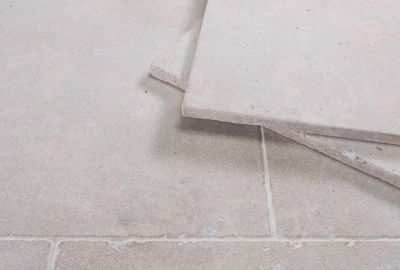While there are many natural stone tile options out there, when it comes to materials that are both long-lasting and classically aesthetic, then it’s hard not to go with a traditional Jaipur limestone.
Both hard-wearing and ideal for both traditional and contemporary home styles alike, here’s what you need to know about what Jaipur limestone is, where it’s sourced from, and how it compares to Jura limestone and Dijon limestone.
What is Jaipur limestone?
Like all forms of limestone, Jaipur limestone is a specific form of sedimentary rock made from a combination of calcite, minerals, and fossils, compressed together over millions of years to form a solid stone block.
As a result, you’ll likely find a mix of plain stone, small, fossilised remains, and calcite veins in any Jaipur limestone tile, though plainer stone is far more common in this variety than Dijon and Jura limestone.
Naturally, there’s more that goes into identifying limestone from other forms of natural stone tile, all of which you can read about in our guide: ‘What is Limestone?‘.
Where is Jaipur limestone sourced?
As the name suggests, Jaipur limestone originates from India, giving it a far more exotic feeling than Jura and Dijon limestone, which are found mainly in Europe. However, this sourcing distance in no way makes Jaipur limestone more expensive than other limestone types, making it an affordable option for anyone after an oriental feel in their home.
The advantages and disadvantages of Jaipur limestone
While all forms of limestone are similar, especially when it comes to strength and production methods, Jaipur limestone does come with two key advantages over other limestone types – its colour variation and antiquated style.
Unlike Jura and Dijon limestone, Jaipur limestone comes in three distinctly different colour variations – sage, sand, and iron grey. This diverse colour palette makes it well-suited to a variety of kitchen setups and styles, letting you easily match your floor to your cabinets and worktops and letting you find the material and colour combination that works for you.
Alongside this, most Jaipur limestone is styled to be antiquated, with chipped and tumbled edges that give it a weathered and aged appearance. This can help make each slab feel unique, helping to enhance an already traditional aesthetic, though it can also lend a unique feeling to specific contemporary setups.
However, as with all types of limestone, Jaipur comes with a selection of disadvantages that might make it unsuitable for use in your home, such as being naturally porous, prone to scratching, and requiring regular sealing and cleaning (though, if you know how to maintain limestone flooring, it’s nearly always worth it!).
How to look after Jaipur limestone
Although Jaipur limestone might feel more unique than other limestone types due to its origin type, as with Dijon and Jura limestone, Jaipur stone is easy to look after and maintain with the right tools and know-how.
For more information about looking after limestone tiles, why not read our piece on how to care for natural stone tiles, which covers cleaning limestone floors?
With that covered, you should now have everything you need to know about Jaipur limestone, and how it compares to other limestone options. Naturally, if you have more questions on this topic, don’t hesitate to get in touch with our team of experts today, or discover our full selection of tile advice guides for even more interesting insight.


